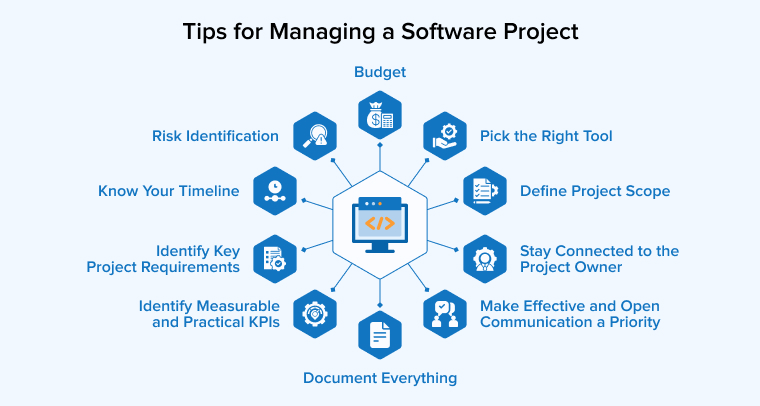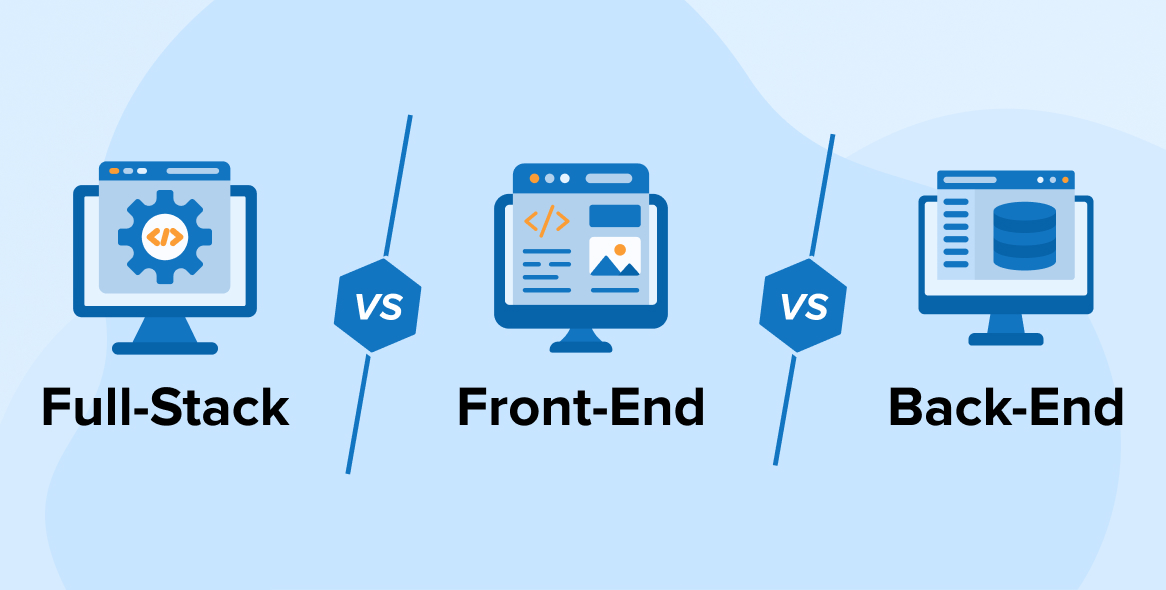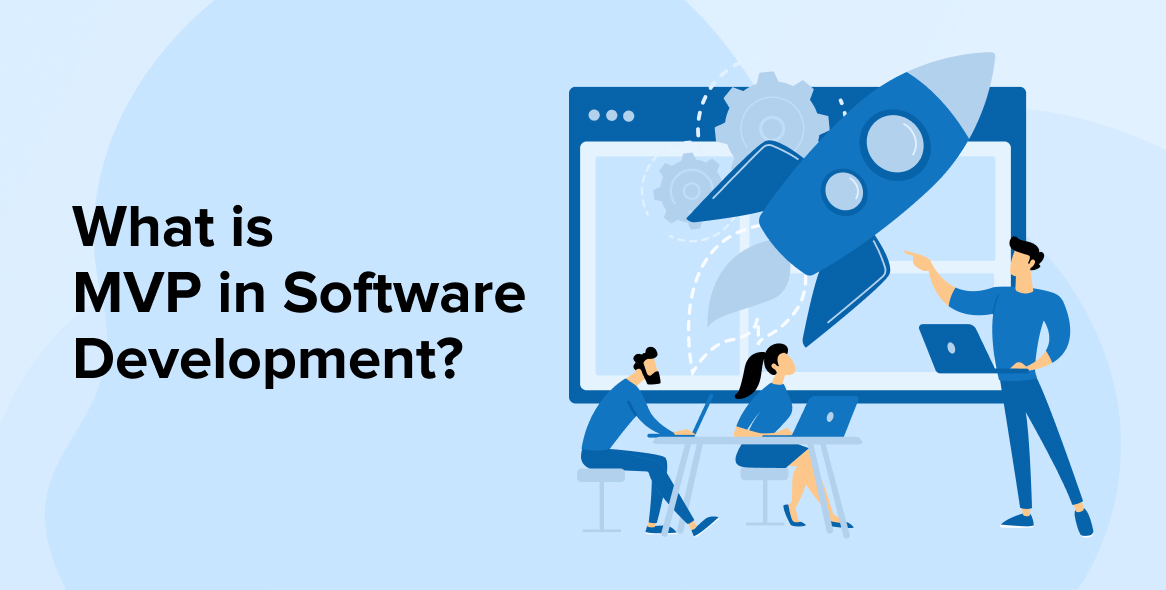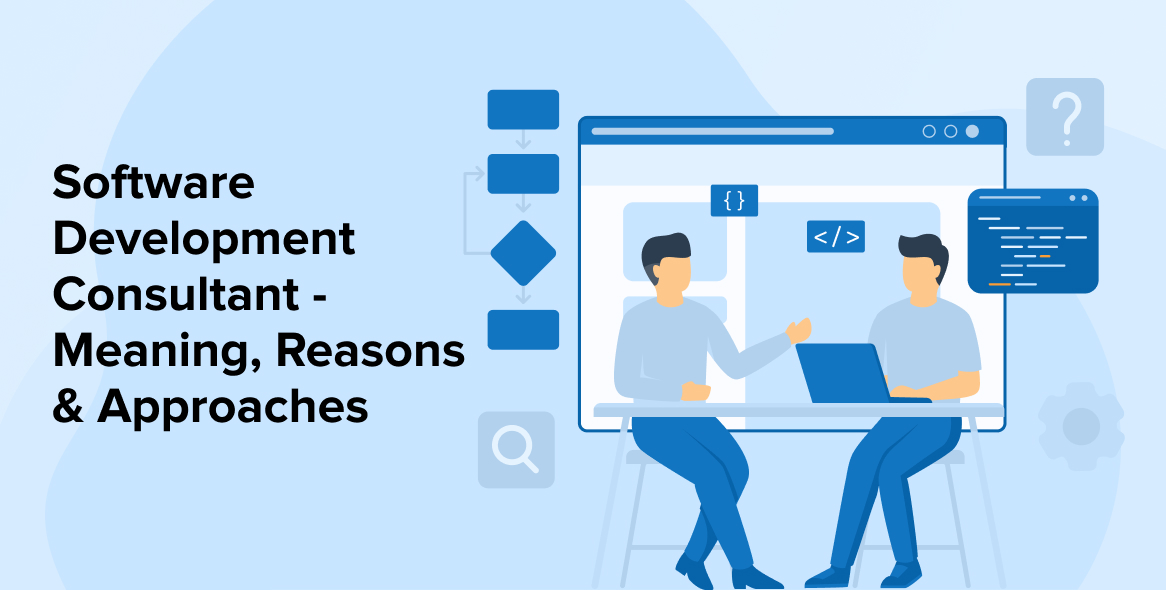
When it comes to developing a new product for the client, one thing that any software development service provider focuses on is having an excellent project management approach as it helps in successfully completing the project. Software project management is a very simple, straightforward, and active process that includes software development planning, resource management, and organization of the entire process in order to complete the product development process on time. This is essential as every proficient project manager would want to deliver the best solution to the client on time. To achieve this, how to manage software projects is a big concern for every project manager or team lead.
Therefore, to make it all clear and help the software project managers create a perfect strategy, here we will understand the software project management concept. Things like why it is important, go through some management tips, and at last, have a look at the benefits of software project management.
1. What is Software Project Management?
Project management is a process that enables the software project manager to define and achieve goals when he is optimizing resource constraints during the software development lifecycle. In short, Software project management is the practice that starts from planning and ends with delivering a software development project within variables like software quality, time, cost, and wider scope.
Just like the software development lifecycle, software project management also has various steps that need to be followed to complete a software project successfully. These four steps are:

1.1 Inception
The very first step of software project management is where the IT organizations identify the scope, requirements, risks, product features, and constraints of the project. Here the software development team will come up with a proper plan that can help them meet the intended budget and support the business and technical aspects of the software product. This plan specifies the following things:
- Define the software development process: Here the project team defines the SDLC (Software Development Life cycle) models, tools & frameworks, and the roles of team members in the software delivery.
- Requirements analysis: All the requirements are gathered and detailed documentation of specifications is created for the software development and operational processes. Basically, a system model is created here to make the team understand the required functional and non-functional operations.
- Planning & budgeting: Once the project scope is defined, it can be used to decide the schedule, resources, and budget of the project. Here, different milestones are created which must be achieved by the development team on a particular time schedule. This plan helps the software development team to complete the project on time and within the pre-decided budget.
1.2 Defining the Requirements
The next phase of software project management is where the team validates the project plan and its design. After that, the team members identify potential risks that might come while working on the project. This means that after agreeing on the project’s vision, the software development team will have to follow these tasks to achieve the goals:
- Risk Management: Here the team members have to understand how they can mitigate or manage the risks of the project. For this, they prepare a playbook that lists out all the probable risks and the best practices that can be followed to manage them.
- Modeling & Design: In this stage, the system and its environmental model is simulated after the selection of a well-suited technology stack, SDLC framework, and product architecture. Basically, this model includes all the interactions that happen between the system components and other outer factors. For modeling and designing the software, some of the popularly used SDLC models are Agile and DevOps.
- Plan Execution: The last thing to do is assign the roles and responsibilities to all the software development team members and managers. Then the identification of the required services or tools is done and the software development starts through a systematic governance framework.
1.3 Provision Management
The third step of software project management is where the actual software development management process starts. Here the team lead will monitor the progress of the development process against the pre-decided requirement analysis. This phase ensures that the multiple teams working on the project are staying on track with user expectations and timelines. Besides, the employees working on the project must be given the required education or training. The important tasks of this stage are as follows.
- Detailed Designing: The designing team gives a detailed description of the documentation and architectural design to guide the other software developers. This includes detailed information about the product’s components, features, and build.
- Quality Management: Managing the quality of the project is very important, so in this stage, the qualitative and quantitative measures of the project are identified. Basically, after the proper analysis of the software, proper measures are taken to achieve high quality.
1.4 Releasing the Product
In the final phase of software project management, the team validates the final product by checking the system against all business and technical requirements specified by the clients at the very beginning of the software development phase.
Here the team members complete all the artifacts and prepare themselves for the next iteration of the software development cycle. The next iteration is to give continuous after support to the client. This means that as per the SDLC methodology when it comes to releasing specific feature updates or the complete developed product it is carried out in this stage. Some of the important tasks that are included in this stage are:
- Evolving: Here the details of the things that can help the development teams to move towards the next iteration stage of the project are specified. The iteration may create a functioning feature component or a software build as per the SDLC framework.
- Feedback: Feedback is taken from the team members to identify the challenges and opportunities that were experienced by the designers, developers, and testers working on the project. And this helps to apply the lessons in the next iteration. For this, generally, the DevOps feedback loop is used. For the software development companies that follow DevOps and Agile SDLC frameworks, taking feedback is an integral part of the entire process. The development team takes the feedback in the subsequent iterations in the first three phases of the software project management approach as it helps in making instant changes in the last stage.
- Project Completion: After finishing the feedback process and completing the project successfully, the performance of the project and its success is measured to determine whether the goals of the project were achieved as per the agreed scope, quality, time, and cost. After measuring all these things, the document of project closure is created and a post-implementation review is conducted by the software development team. This makes sure that there are chances of retrieving the team for future implementations. And after that, the relevant teams of the project are debriefed on the project performance.
2. Tips for Managing a Software Project!

Some of the major tips that every project management software team member must follow:
2.1 Define Project Scope
The first thing to do while managing the project is to settle down with all the concepts of the project and then lead the initiation as per the project idea. This initiation phase generally starts with a piece of paper and pen where the project manager draws the project idea on what is required to be done after the proper research of the project. The project managers and team lead together list out the major points and get approval from stakeholders which helps in developing the project charter. The project charter is nothing but a document that specifies the overall project scope.
2.2 Identify Key Project Requirements
To manage a software project in the right manner, the team member must map out the key requirements of the project before starting the development process. This includes answering the questions like – Will there be a need to take routine approvals from the stakeholder at every step? Is there a need for a specific skill set for a particular project?
The requirements must include everything that a project might require and this involves things like a list of stakeholders, project deadline, resource requirements, project deliverables, managing clients, and more. This means that before starting the development process, the team members must list out key project requirements to keep everyone and everything on the right track from the beginning.
2.3 Risk Identification
When the development team is going through the planning process, one thing that must be done is to figure out the possibility of things going wrong at any stage of the process. This is known as risk identification or risk analysis. It helps the designers and developers in assessing the risk and formatting a plan to rescue if the risk occurs.
Basically, identifying risks can help the development and quality assurance team to be ready for anything from the very beginning. Here, when the team is defining risk, it must be categorized into three different types – Low, medium, or high. The risk identification document must also heighten awareness of the issues that might occur while working on the team as it can help save a lot of time and money.
2.4 Make Effective and Open Communication a Priority
Communication is the key to anything. Having clear communication can be a reason for successful project execution. It has the power to steer the project in the right direction. Besides, open communication within the team ensures expected project outcomes. Basically, it lays down clear project objectives and goals.
2.5 Pick the Right Tool
As much as choosing the right software development team is essential for any project, so is selecting the right tool to manage the project. A good and user-friendly tool is a lifesaver. It created a huge impact on overall project management as it brings the people working on the project together and helps them to achieve shared business goals. An ideal tool must bring transparency to the software development project and offer the following features:
- Task and resource management.
- Automation capabilities.
- Time tracking.
- Multiple project views.
- Seamless file sharing.
- Instant messaging and task comments.
Having such features can lead towards having enhanced team productivity, increased project visibility, improved collaboration, and better project outcomes. Some of the best project management tools available in the market are Atlassian JIRA, Trello, and Asana. These tools help programmers in managing multiple projects with maximum efficiency and ease. It instantly takes control of the daily tasks of all the team members with its intuitive user interface. Besides this, it also comes with features like automation, file sharing, multiple project views, and more.
This shows that such tools can help teams to coordinate with each other effortlessly and work together to achieve the same goal.
2.6 Identify Measurable and Practical KPIs
KPIs (Key Performance Indicators) are the metrics that are used to define project success. KPIs vary from one project to another. They are generally discussed during the requirement gathering process and they help the software development team in assigning a quantitative value to the ways required to make the software perform as per the client’s requirements. For instance, a metric for an eCommerce solution might include the number of online shoppers that might place an order at the same time, and then a solution is defined that specifies how the system will not crash even after so many buyers purchase things at the same time.
2.7 Know Your Timeline
Specifying the project timeline is very important as it gives a clear idea to the client and the team member about the project completion time. So, when the team leads are creating the project plan, they must also estimate the time for each task to meet the software development project deadline which is fixed by the mutual understanding of the project manager and the client.
2.8 Budget
One of the most important things that must be discussed before starting the project is the budget. Generally, the clients give a budget to the software development company and if the customer doesn’t have a fixed budget but only a ballpark figure, the development company analyzes the project and gives a final figure to the client. Be it any way, the budget must be fixed before the development starts. This helps the project manager assign the resources and choose the tools accordingly.
Besides, the project manager will monitor the project’s budget consistently to keep a track of the expenditure in order to remain within the pre-decided budget. Working according to the budget is the most important skill any project manager can have.
2.9 Document Everything
While working on software development projects, one of the most important things to do is to keep everything documented. Technical documentation is the most essential part of any project. The project managers in software development teams must ensure that every milestone of the development process is accurately recorded and stored for future reference.
Besides, if the data is recorded, it can be highly beneficial while checking the project progress reviews and hitting the delivery milestone. It also acts as a referral point for the developers when they are working on different project implementations. Therefore, proper documentation must be created.
2.10 Stay Connected to the Project Owner
While the project development process is carried out, the project owner must also be kept in a loop. Everything that happens in the project, every decision that the software project manager or team lead takes for the betterment of the project must be run through the project owner. There must be a constant connection with the project owner and he must be kept updated with the project progress report. For instance, the project owner must know how the team is performing, what bottlenecks they are facing, the features of the software, and more.
Besides, feedback from the project owner must be taken by asking questions like:
- Are there any concerns about the software project development method?
- Are there any suggestions for a better outcome?
- Do you want changes in the scope of the development project?
All these things help in creating customer satisfaction.
3. Benefits of Software Project Management
Some of the advantages of software project management are:
3.1 Improved Efficiency
Software project management helps in improving the overall project efficiency and this is because of the clear roadmap that is offered to the software engineers and leads them towards successful project completion. Basically, when the software designers and programmers get a clear project roadmap in their hands, they can work smartly on the project.
3.2 Greater Flexibility
One of the biggest advantages of good project management is flexibility. Any project management tool or approach used by the development team comes with an accurate strategy to complete the project successfully within the pre-decided timeframe. It also offers smarter directions to the team members when they are developing software for both small to midsize companies.
3.3 Improved Growth
Project management helps in boosting the team’s morale and this eventually enables improving the growth of the project. It offers new opportunities to perform better and get good & positive results which put your software development company ahead of others.
3.4 Expand Your Services
With the help of good project management, the team members can expand their services and help clients find more business opportunities to capitalize on. This can eventually help businesses to offer better services to the end-users and expand their market.
3.5 Better Customer Satisfaction
The biggest advantage of project management is better customer satisfaction. As it helps the development team to complete the project on time and within the pre-decided budget, the customer leaves with the end product happily. This means that the chances of the customer coming again to you for another project are higher. The happy client will also recommend your firm to other business organizations and this is a very good thing.
3.6 Increased Productivity
One of the benefits of having a proper project management approach is increased productivity. When any company works for a client’s digital transformation using better and greater quality project management, it will help in increasing the productivity of the team members. It enables the programmers to create, manage, and execute the project efficiently & effortlessly.
4. Why is Software Project Management Important?
For any business organization, its software solution is known as an intangible asset. Generally, software development firms create tailor-made products for their client’s to fit all of their requirements. This is important as there is frequent change and advancement in the technology and the business requirement which doesn’t allow one system to be used by different businesses. All these types of constraints bring risk to the software development process which makes usage of the software project management approach more important.
Software project management has become an important part of the project development process as it helps in delivering a quality product and also keeps the client’s constraints like project requirements, budget, and time in check. Besides, there are chances that while the team is creating a project they might miss out on any one of the constraints which can also severely impact the other two. This is why companies follow a proper software project management approach to incorporate user requirements with time and budget.
5. Conclusion
As seen in this blog on how to manage software projects, when any business organization hires a software development company to have quality software with new features and user-friendliness, meeting the project goals and deadline are the potential challenges for the development team. This is why software project managers prefer to have a perfect project management approach for which they might use the latest tools with an effective SDLC method. This helps them manage any project effortlessly and deliver it as per the client’s requirements.






Comments
Leave a message...